With thousands of knives flooding the markets, it might seem like there’s so much overlap out there that all knives start to bleed together. If you actually believe that new knives no longer have much to offer, you have a lot of studying to do.
Every year manufacturers and designers work hard to bring something new and exciting to the table. To better illustrate how new knives are still proving their worth, we thought it’d be interesting to take a look at all the winners of Blade Magazine‘s “Overall Knife of the Year” award since the start.
The winners of this award are voted by attendees of the BLADE Show and a panel of special judges. These knives are typically prototypes at the time, but show real craftsmanship, expert designs, beautiful construction, and much more.
The first BLADE Show took place in 1982. From what I could find, the first Overall Knife of the Year award was given to a Fight’n Rooster knife, though I couldn’t pinpoint the model, so I didn’t add it here.
Also, the show did not have an Overall Knife of the Year winner in 1983. If I am wrong, please let me know. So with that, let’s start with the knife that won the award in 1984 and work our way to the present.
1984: Timberline Survival Hunter
(The image is of a skinner version of the knife made by Timberline’s Vaughn Neely. These old knives are hard to find.)
The Survival Hunter is a design by Vaughn Neely, who founded Timberline, and was a beloved knife. You still see these vintage Survival Hunters for sale but they tend to go very quickly. Like I said, these earlier knives are difficult to find information on, but it also won the American Made Design of the Year in 1985.
1985: Gerber Clip-Lock

The Clip-Lock from Gerber was a Black Collins design that’s now long discontinued. It had an unusual sheath design in that a clip locked it into place. Here is a quick video overview:
1986: Fight’n Rooster 7-blade Congress
I’m honestly not too familiar with Fight’n Rooster Knives, but I was able to find out that the company was started in the ’70s by Frank Buster. Most of them were traditional slip joint designs typically made in Solingen, Germany. This 7-bladed Congress was all I could find of the knife, but if it’s not the correct model, please let me know.
1987: Buck Titanium

The Buck Titanium was an interesting design with a titanium handle and an overall design reminiscent of the Buck 110 Folding Hunter. It had a monstrous pocket clip, which you can kind of see in the image above. It had a back lock and was just a solid knife.
I believe it came back as the Buck 560 Titanium without the clip and with a few changes, but the original was the Buck 186 Titanium. The 186 was discontinued a year later but came back the year after that in the 560. That’s been discontinued too. Here’s more info on BladeForums.
1988: SOG Tomcat

The SOG Tomcat is probably a familiar name (it was a Badass Knife of the Week in the past), but they’re currently on the Third Generation. The one that won the Blade Show award in 1988 was the First Gen. When it was first released, it set the standard for large kickback folders and was mighty impressive.
Since then, the Tomcat has only gotten better with the Arc-Lock, VG-10 steel, and Kraton handle scales.
1989: Blue Grass/Winchester W15 1927

I couldn’t find much about this traditional design. Blue Grass Cutlery made some Winchester designs if I’m not mistaken. If anyone has any info, please contact me.
1990: Spyderco Endura

The Endura is a legend that changed the knife world as we know it. This game-changing model came out the same time as the Delica and has since become one of Spyderco’s iconic models. The original Endura was made with Zytel handle scales and often featured AUS8 steel.
The now fourth generation of the Endura features VG-10 steel, multidirectional FRN handle scales, and comes in a ton of variations.
1991: Timberline Timberlite

This was another Timberline knife, but this folder had the Neely lock. You could open it with the thumb studs with one hand. Closing it was a bit different though. You pull up the blade to release it. Here is a great look at its history:
1992: Gerber Multi-Plier
(The image is of the updated version of the Multi-Plier.)
The Gerber Multi-Plier is still around in some form. It was pretty interesting to get this as one of the Overall Knife of the Year winners because it was not necessarily only a knife.
1993: Spyderco Snap-It

The Snap-It is an interesting little folder with a carabiner-styled clip that was a popular EDC. It was discontinued in the early 2000s, but it has since come back as the Snap-It Salt, which is now more designed as a boating knife. Take a look to see how it works:
1994: Buck CrossLock

The Buck 180 CrossLock has since evolved into a popular line, but this was the OG. It had two blades in the knife that opened like any other single-bladed folder. When you wanted the straight edge blade, you opened it from one side. When you wanted a gut hook with a blunt point, you opened from the other.
1995: Spyderco Silhouette

If you’ve never heard of the Spyderco Silhouette that’s OK because it was quickly renamed the “Q”. The Spyderco C35 “Q” was renamed because of some copyright issues with the name, but the knife was insane. It had a cutout design in the blade and handle. It came in a ton of color and cutout design variations.
1996: Buck BuckTool 360

Leatherman was dominating the multitool market, but Buck wanted to make its own impression with a plier multitool that was unique. That’s where the BuckTool 360 comes in. Here is an excerpt from the multi-tool.org.
Although Leatherman already dominated multi-tool sales, Buck received a years worth of orders for the BuckTool 360 within a few hours of its release. Much of the popularity of the BuckTool is due to the ingenuity of Splane Design, an industrial design and product development company. In order to avoid purchasing rights to use the patented designs of Leatherman, Buck contracted Splane Design to develop a “two axis hinge” multi-tool. The result was a uniquely styled tool that opened by rotating the handles in opposite directions.
1997: Boker Super Liner

The Boker Super Liner was a sleek liner-locking folder that was very popular. Its design was well-conceived and was said to fit in the hand perfectly.
1998: Outdoor Edge Kodi-Pak
The Outdoor Edge Kodi-Pak is a kit for hunters that includes pretty much everything a hunter needs to dress, skin, and quarter game in the field. It comes with a leather sheath for easy carry as well.
1999: Emerson Knives Commander

The Emerson Commander was a revolutionary design. Ernest Emerson set out to create a true tactical knife for those in the line of duty. I believe it was the knife that helped inspire the Wave feature and was the first Emerson knife to have it.
2000: William Henry S07

(This image is actually of a more recent version of the S07)
The WH S07 is an elegant gentleman’s folder with a frame lock design and wharncliffe blade. The fit and finish was impeccable and the design is downright handsome.
2001: M.O.D. CQD Mark V ATAC

The Masters of Defense CQD Mark V ATAC (Advanced Tactical Combat Fighter) is a frightening knife that boasts a nonconducive handle with a built-in pommel and a modified spear point blade made from A2 high carbon steel.
2002: Kershaw Rainbow Leek

The Kershaw Leek was already one of the most beloved knives ever at this point, but when Kershaw decided to add some unique coloration using a new process, it took home the top prize. The recently discontinued Rainbow Leek featured a multi-colored finish that comes from a high-tech process known as Physical Vapor Disposition (PVD).
Here is something I wrote earlier: To get the rainbow color, metals were ionized with a high-current, low-voltage arc then placed in a vacuum chamber along with the Leek’s parts. A negative voltage was introduced and a micro-thin layer of metal permanently coated the blade and handle. By introducing titanium oxide and oxygen to the process, PVD is able to create the rainbow coloring you see on the Rainbow Leek.
2003: William Henry Westcliff

The Westcliff is another sleek and lightweight folder from William Henry. It had a button lock mechanism and handsome flourishes that made it stand out. To see more high-end pocket knives, visit Windsor.
2004: CRKT/Ed Van Hoy Snap Lock

Remember the Snap Lock? It’s back! When it was first released, the Ed Van Hoy design was breathtaking and pushed the limits of design. You push down the cam stud and swing it open from its side and you do the same thing to disengage.
Here’s an explanation from CRKT:
2005: Kershaw/Onion Offset

The Offset is a Ken Onion design from Kershaw with a cool spider web type design on the handle. Like most KO knives, it uses the SpeedSafe mechanism and locks with a stud lock, which is similar to the Kershaw Speedbump.
2006: William Henry GenTac CTD

The GenTac is a meld between gentleman’s folder and tactical, thanks to its functional and hard-use design that’s also stylish. It has a push button lock, damascus blade, titanium frame with carbon fiber inlays, and sapphire insets.
2007: Kershaw Tyrade

The now discontinued Tyrade featured a composite blade made with D2 steel and 154CM. The titanium handle scales were dressed up with carbon fiber overlays.
2008: Chris Reeve Knives Umnumzaan

The CRK Umnumzaan was built with inspiration from the unparalleled Sebenza. It has an inventive design and uses the Ceramic Ball-End Integral lock. It has a large pivot and prides itself on its strength.
2009: Lone Wolf Defender

The Lone Wolf Defender made our list of knives with unique opening mechanisms and uses the Paul Axiel locking mechanism. You can open it by holding the pivot between two fingers and then using force to swing the handle open. The one pictured above is a version from Benchmade, which acquired Lone Wolf Knives in 2010.
2010: Chris Reeve Knives Ti-Lock

The Ti-Lock was a collaboration between the ingenious father/son duo of Grant and Gavin Hawk and the great Chris Reeve. The Hawks approached Reeve with a new locking mechanism. The knife takes the lock out of the frame and places it up on the spine of the blade. It’s durable and great to use.
Earlier this year, CRK announced that it wasn’t making the knife anymore because of its difficulty to produce and high-concept lock that many people simply didn’t glom onto.
2011: Zero Tolerance 0777

The ZT 0777 began the three-year streak of wins at the Blade Show for Zero Tolerance. The knife was one of the most demanding knives the company ever produced due to some issues obtaining materials. It had a composite blade with Damascus and a cutting edge of Vanax 35.
The knife has come back in a few forms, including the recent Natrix. There is also a whole controversy surrounding the knife that I won’t go into here. Just Google “Microtech Natrix lawsuit.”
2012: Zero Tolerance 0888

In 2012, the ZT 0888 took home the top prize. It was a large folder that was more than nine inches long with a blade of 3.75 inches. The flipper used a composite blade with a CPM-S110V steel cutting edge and 14C28N steel spine. It was a classic titanium frame lock flipper.
2013: Zero Tolerance 0454

The ZT 0454 is a design by Dmitry Sinkevitch and has received effusive praise as one of the best knives around. It has an amazing composite blade with a D2 cutting edge and spine and 12C28N middle. The pieces are braised together with copper and look fantastic.
The carbon fiber handle is 3d machined with titanium backspacers and a reliable subframe lock.
2014: CRKT/Ken Onion Hi Jinx

Ken Onion made his triumphant return to the top with CRKT’s Hi Jinx. The knife was the company’s first real foray into the world of high end knives. The Edge Observer did a great review of the knife back in 2014. Here is a good overview of the premium knife:
After having a look at the sum of the Hi Jinx’ parts, it’s easy to conclude that CRKT is getting more competitive while widening their scope. This is evident in the materials, price point, designer and OEM choice. Outside of this folder it can also be seen in an increased model diversity that can be attributed to the new designer collaborations they are nurturing.
For 2017, CRKT released a budget version of the knife called the Hi Jinx Z.
2015: LionSteel T.R.E. (Three Rapid Exchange)

The LionSteel T.R.E. is a titanium frame lock flipper that allows the user to carry the knife with or without the flipper mechanism. IKBS ball-bearing pivot system makes the opening of the knife smooth and quick.
The knife is so named because it allows you to carry it in three ways: “a simple basic version without Flipper and pin on the blade, a Thumb Stud version with the pin on the blade or adding the flipper for a quick opening action.” It was well-received by Everyday Commentary.
2016: Lionsteel KUR Metamorphosis
The KUR Metamorphosis is a study in quality and craftsmanship, but the real award-winning feature comes in the changing handle. It features a special heat-sensitive coating that changes from black to camo, depending on the temperature. Take a look:
2017: Lionsteel SR-11
Lionsteel stretched its win-streak to three years thanks to the spectacular SR-11, which evolved from the 2010 innovative knife award winner SR-1. The frame is a single piece of steel worked with 4-axis machining and is smooth as butter. Knives are a matter of preference but it’s hard to ask for a better knife. We’ll see how history views the SR-11.
2018: Fox Knives SURU

The SURU is designed by the great Jesper Voxnaes and features the first frame lock that uses 90 percent carbon fiber and 10 percent TPI stainless steel. As you can imagine, it’s incredibly lightweight at about 2 ounces.
2019: Fox Knives Radius
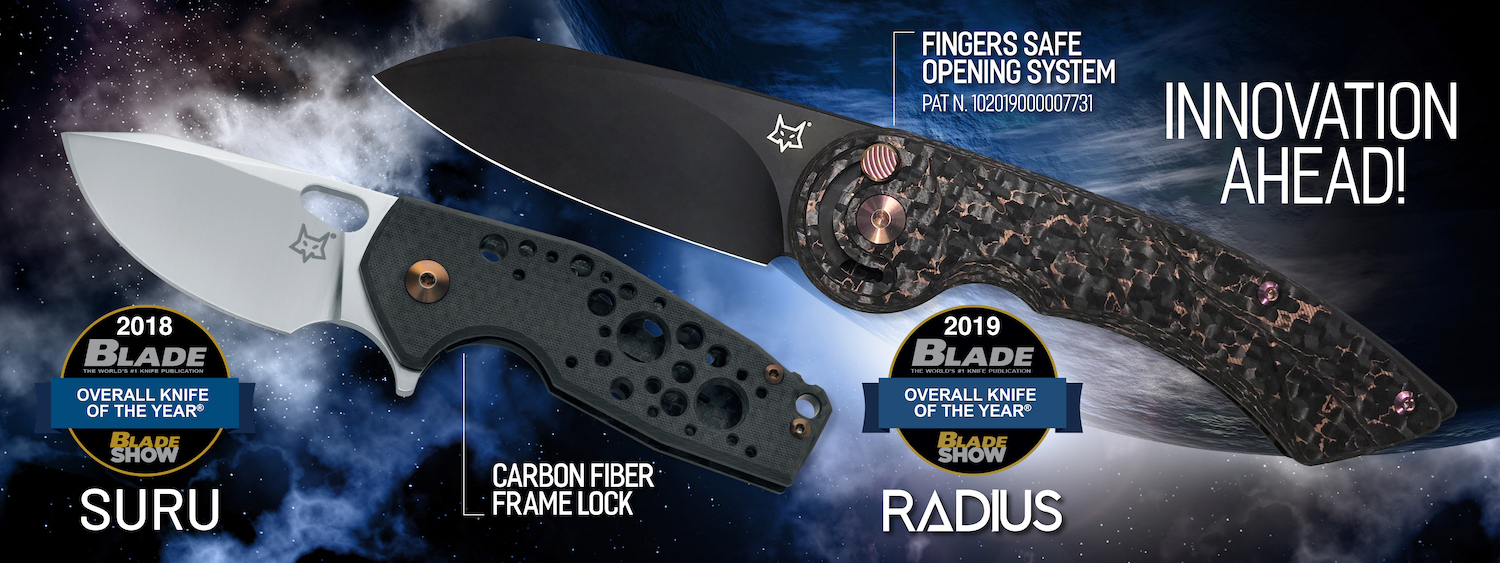
Fox Knives took home another prize in 2019 with another innovative knife. This time, the knife boasts a fingers safe opening system.
2021: Fox Saturn
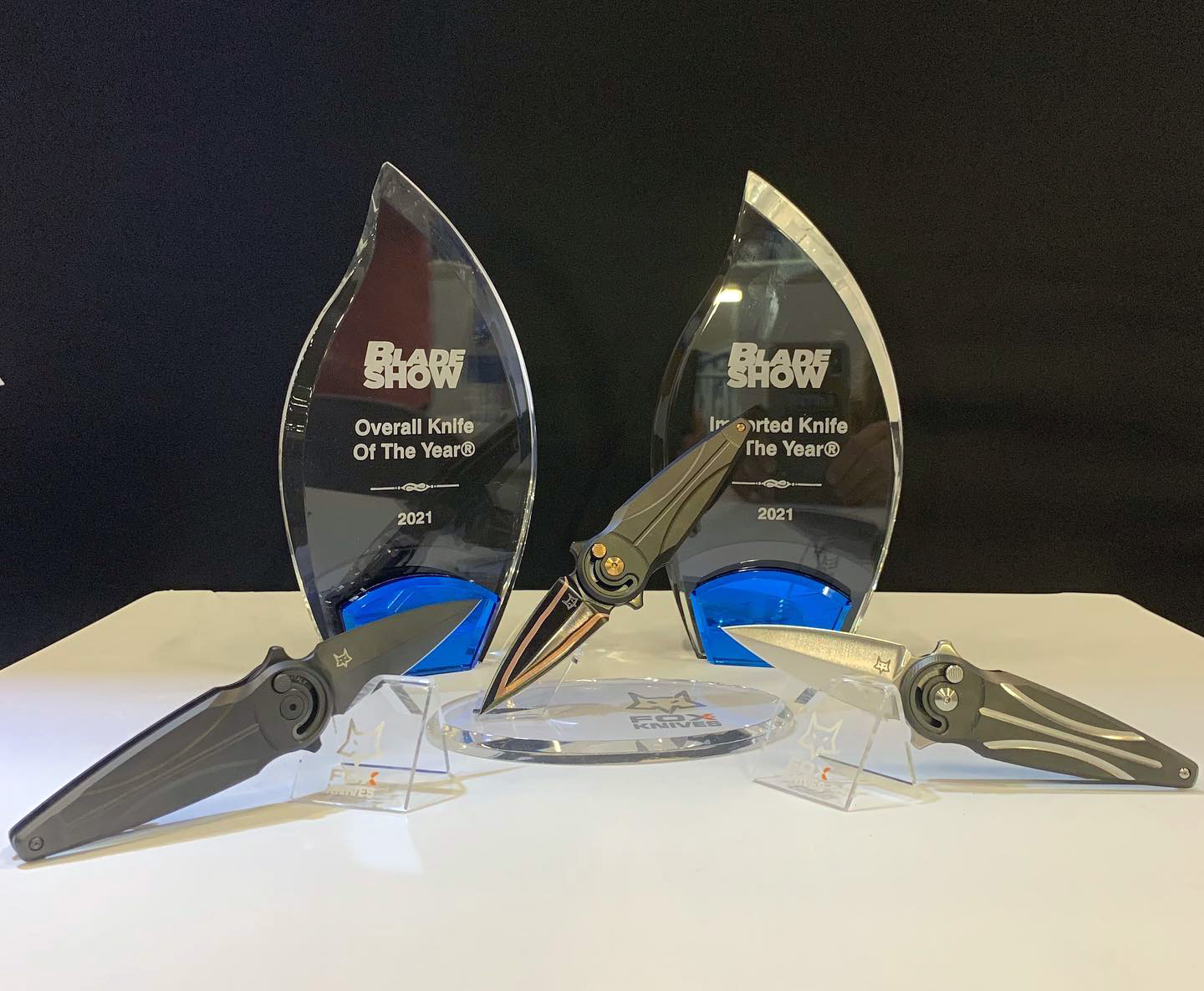
For the third year in a row (ignoring the lost COVID year of 2021), Fox Cutlery took home another award in 2021 for its Saturn. The Saturn uses an innovative Radius Lock to open and close the knife.
Take a look:
2022: Pro-Tech Malibu Operator

In 2022, Pro-Tech took home the top prize for its Malibu Operator. The Malibu, with its manual flipper blade and button lock, was not a new design that year, but it seems like the knife qualified for being a part of Pro-Tech’s Operator series.
This knife has a 3.3-inch reverse tanto blade made from 20CV steel with an all-black look.
2023: GiantMouse GMX

The GiantMouse GMX is a downright gorgeous knife and won the Knife of the Year award in 2023. It has a 3.27-inch S90V upswept blade with an Integral titanium handle and brass inlay. It is essentially a slightly larger and more premium version of the popular GiantMouse Clyde.
There are only 400 versions of the X made.
2024: Spartan Blades Clandestina
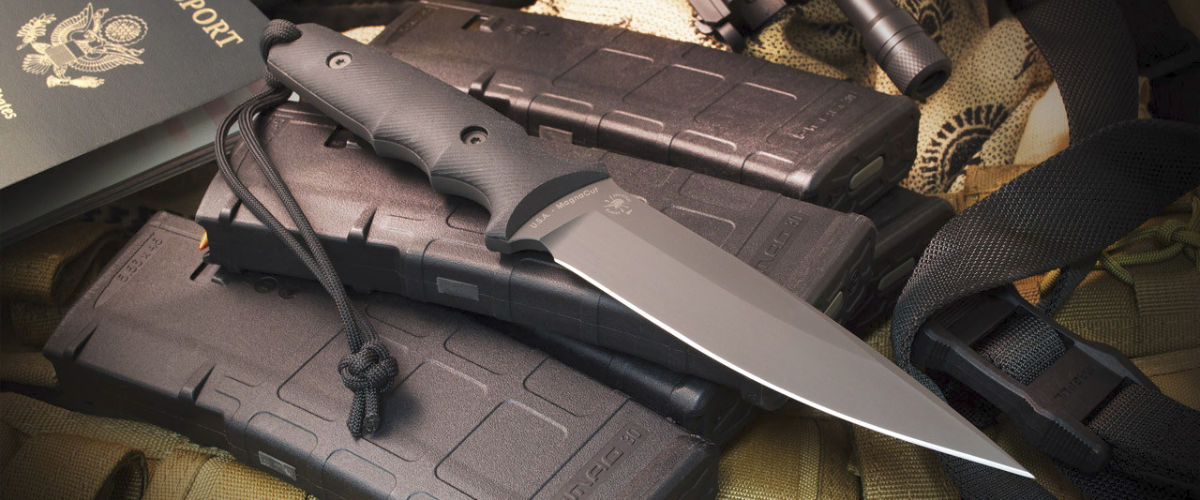
Spartan Blades teamed up with Bill Harsey to create the Clandestina. This meticulously crafted fixed blade features a 5.5-inch MagnaCut blade with a Micarta handle. It appears that the knife won the award based off its cohesive design, premium construction, and legacy.
There’s not too much to take away from the Overall Knife of the Year award winners over the past 30+ years, except Zero Tolerance and Kershaw are killing it.
Let us know if you think we should go back further or show some of the other categories like Imported Knife of the Year.

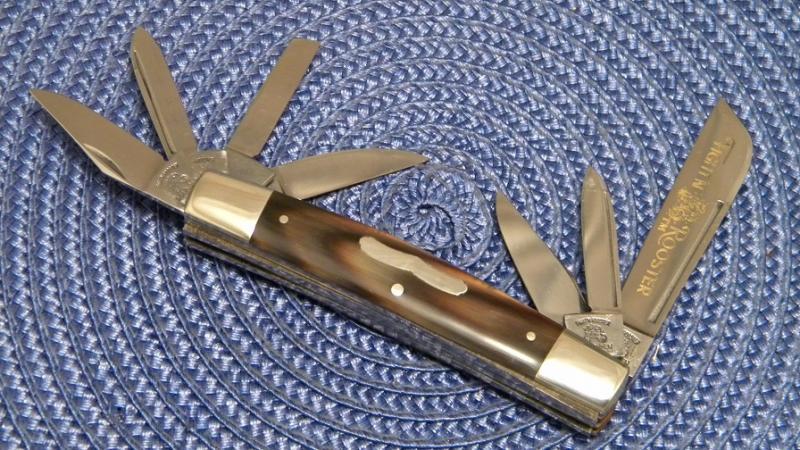
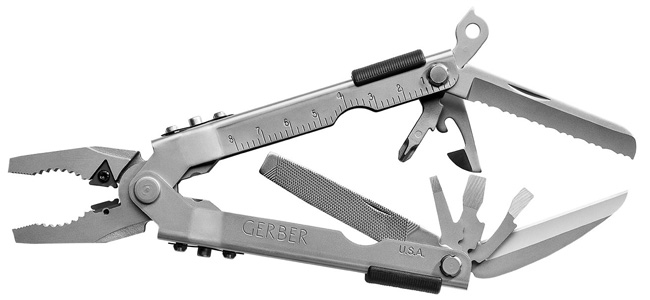
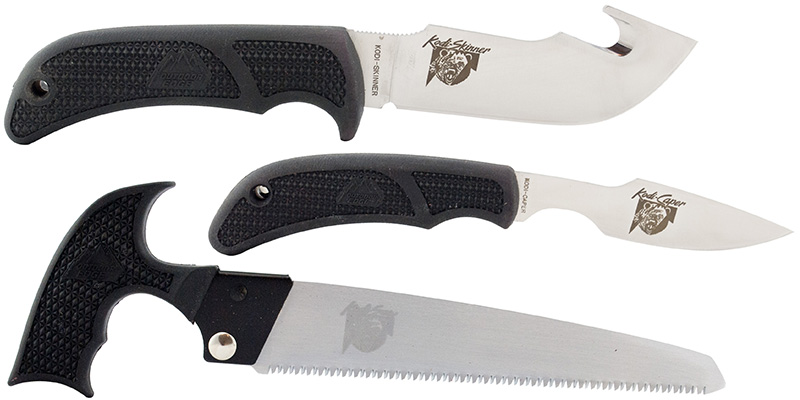






November 15, 2013 at 1:05 am
I am a knnife lover and was pleased to see your website, especially Knives of the years. Well done and keep it up.
November 15, 2013 at 8:53 am
Yall aughtta take a look at the “BENCHMADE VOLLI” with S30V stainless. NOW T H A T is a winner!
November 15, 2013 at 11:32 pm
As a tactical knife lover, I find most of these (all except the Chris Reeves) ugly as sin.
September 15, 2020 at 9:57 am
me too!!!
November 22, 2013 at 1:34 am
you have very nine knife list. well done. this time can take for gift in holiday
December 6, 2013 at 7:02 am
Of all the working blades that I have used the best knife that I have come back to it the 2005: Kershaw/Onion Offset, why? well after over 24 months of combat duty this knife went with me out side the wire the dust the wind and a many Ft. Drum FTX’s it stayed the same; kept the same edge opened the same. I once cut a sheep from a barbed wire with a M240 covering my back just to save a sheep that was hung up in our wire, the knife is tough it works. Many thanks to Ken onion for a great combat knife.
November 28, 2018 at 5:36 am
Triple Deuce 11B 01-06 here. What unit were you?
December 9, 2013 at 1:23 am
wow CRKT/Ed Van Hoy Snap Lock knife design is so attractive. thank you for sharing this information with us..
April 12, 2016 at 9:02 am
What would it take to acquire all 15? Or 10? Maybe just the past five years? I’m asking a sincere question.
A light weight Collector – – of sorts.
April 12, 2016 at 12:26 pm
Getting all the winners from the past five years will likely set you back about $5,000, considering you’d have to find most of these on the aftermarket. Not only that but many of them are limited. To get them all? I’d guess a small fortune.
If you just want one or two, pick up the Rainbow Leek or LionSteel TRE. Those are the only you can get without going through someplace like eBay.
November 23, 2018 at 12:41 am
Have you found and info on the 1982 Knife of the year?
I’ve been looking for 1982 knife of the year for two years and still have no idea what it looks like or how many blades it has.
If you ever find the 1982 Knife of the Year Fight’n Rooster information – could you send any info you find.
I started collecting the Knife of the year in 2016 and in 2018 got them all, too my satisfaction, but the 1982 Fight’n Rooster.
The 1999 and 2000 were the last, and not mint. I only seen one 2006 knife of the Year for sale and bought it, even though the bolsters were dye purple.
Thanks in advance for any help you can give me.
Regards,
Pat
cardzonecards@sbcglobal.net
February 14, 2017 at 8:34 am
I’m thinking these awards don’t always bring the right recognition to the table. As I look back on these knives it seems like most, except two or three, have become forgettable over the years, and some aren’t even in production anymore.
February 14, 2017 at 3:30 pm
Where is the spyderco para 2 and Kershaw Emerson collaberations…this list is a joke.
June 7, 2017 at 11:24 am
1983 was Timberline’s SA Hollow Handle Survivor. Yep, they won twice in a row. And yes, it was a “Rambo” knife.
June 8, 2017 at 10:23 am
Awesome! Thanks for sharing. I couldn’t find that info anywhere. I was only able to verify with a single line on Gil Hibben’s site, but I think that’s good enough for me. I’ll update this post soon. Any idea about which Fight’N Rooster knife won in 1982?
April 7, 2018 at 5:38 am
Father & Son Knife Makers
August 7, 2018 at 12:09 pm
Another great little article. Well done
November 28, 2018 at 5:40 am
This list was awarded by BladeShow…they are not KnifeDepots choices. All you guys saying “this list is crap because you didnt include my favorite knife!” are stupid. The knives were chosen because there was something innovative about them…I think they all qualify.
March 15, 2022 at 2:13 am
I personally owned the winner from 2002 the Kershaw Ken Onion Rainbow Leek I bought it back in 2010 for $100 and it was worth every penny. It had a razor sharp edge to it and with the spring assisted opened it was basically a switch blade. I wish they weren’t discontinued because I would buy another one in a heart beat. Again by far the best knife I have ever owned and worth every penny.
March 15, 2022 at 2:16 am
Forgot one thing it was obviously a beautiful knife and it was an attention grabber people definitely noticed it and would contstantly be asked how much it cost and where it could be purchased.
August 10, 2022 at 1:09 pm
A great look back, thanks! And you are correct, Ernest Emerson introduced his Wave feature to the production knife market on his Commander model.
August 11, 2022 at 2:58 pm
I thought so. Thanks for letting me know!
August 11, 2022 at 3:18 pm
I still have my 1993 Spyderco Snap-It in red/black with Spydie Edge. Great knife, very sharp, and the carabiner makes it very useful to attach to a belt loop or pack. Thinking about getting the all yellow salt Snap-it for fishing, and just to have both models.